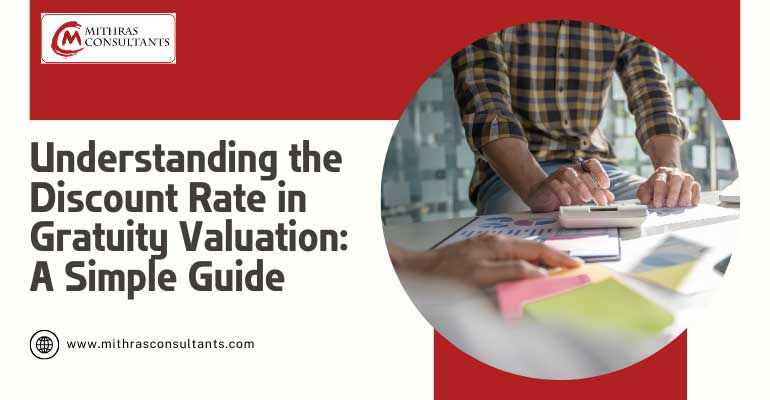Understanding the Discount Rate in Gratuity Valuation: A Simple Guide

Every employer must value gratuity obligations accurately. It will help them maintain financial stability and regulatory compliance in future. Gratuity is a long-term benefit that employees receive after completing five years of service. For businesses, proper valuation ensures they are prepared to pay this liability when due.
But here’s the catch. One small number—the discount rate in gratuity valuation—can change everything. What is this discount rate? Why does it matter? And how does it affect your balance sheet? Let’s break this down.
What Is the Discount Rate in Gratuity Valuation?
The interest rate used to determine the present value of upcoming gratuity payments is known as the discount rate in gratuity valuation. In order to fulfill their future gratuity obligations, employers must project how much money they will need today.
Actuaries apply the discount rate to these future liabilities. This helps convert them into today’s value. The lower the discount rate, the higher the present liability.
Let’s understand this with an example. Suppose you need to pay ₹10 lakh in gratuity after 10 years. If the discount rate is high, you’ll need less money today. But if the discount rate is low, you must set aside more money now.
Why Is the Discount Rate Important for Employers?
The discount rate directly impacts your gratuity liability. Even a 0.5% change can increase or reduce your liability substantially. Employers must disclose this liability in their financial statements. Auditors and investors closely monitor these figures. Misjudging the rate can lead to inaccurate provisioning.
It also affects your funding decisions. If liabilities increase due to a lower discount rate, you might need to boost your funding or rework your financial plans.
What Factors Influence the Discount Rate?
Several market factors influence the discount rate in gratuity valuation. Let’s look at the key ones:
- Government bond yields: In India, the discount rate usually aligns with the yield on government bonds.
- Tenure of liability: Longer-term liabilities need a different rate than short-term ones.
- Interest rate trends: Central bank decisions influence market interest rates and discount rates.
- Economic stability: Macroeconomic factors like inflation or fiscal policies also affect yields.
What Happens When the Discount Rate Falls?
A lower discount rate means higher gratuity liabilities. This happens because future payments look more expensive when brought to present value. For instance, your balance sheet may show a sudden jump in liabilities. This could worry investors or trigger revaluation of funding strategies. You may also need to reassess your employee benefit provisions. This can impact budgeting, hiring, and investment planning.
How to Choose the Right Discount Rate?
You should not choose the rate randomly. The rate must reflect current market conditions and the nature of your liability. Actuaries generally use the yield on government bonds with a similar term to the gratuity obligation. For example, if your average gratuity payment is due in 7 years, then the 7-year government bond yield is relevant. Using professional actuarial support is essential here. It will help you align your accounting standards and ensure transparency in financial disclosures.
Why Indian Accounting Standards Matter?
Indian companies must follow Ind AS 19 or AS 15 for employee benefit reporting. Both standards recommend using market yields on government bonds for discounting post-employment benefits. These guidelines make your financial reports more consistent and globally aligned. So, companies must update the discount rate in gratuity valuation regularly. This ensures financial statements reflect true and fair values.
How Can Businesses Prepare for Rate Fluctuations?
Fluctuating discount rates can lead to volatility in financial statements. Businesses must proactively manage this risk.
Here’s how:
- Review the rate annually: Don’t stick with last year’s rate.
- Work with actuaries: They can guide you on suitable rates and implications.
- Forecast different scenarios: Test what happens if rates fall or rise.
- Communicate with stakeholders: Transparency builds trust in financial reporting
Why Should SMEs Care About This?
Many small businesses overlook gratuity liabilities. But even small changes in the discount rate can strain cash flow. Small and medium-sized enterprises must seek actuarial guidance. They can avoid surprises and make informed decisions.
How Mithras Consultants Can Help
Managing employee benefits involves more than just calculations. It demands insight, accuracy, and adaptability. Mithras Consultants is an independent actuarial and insurance consultancy firm providing qualitative financial and insurance solutions to its clients. Our goal is to provide business solutions customised to client‘s needs to help our clients make the best possible decisions on their financial, insurance and risk management programs.
Final Thought
Understanding the discount rate in gratuity valuation is vital. It’s not just a technical term—it directly affects your finances. The smarter your decisions today, the safer your business tomorrow.
Still unsure about how the discount rate affects your books? Let’s talk.

 Call Us
Call Us Whatsapp Us
Whatsapp Us